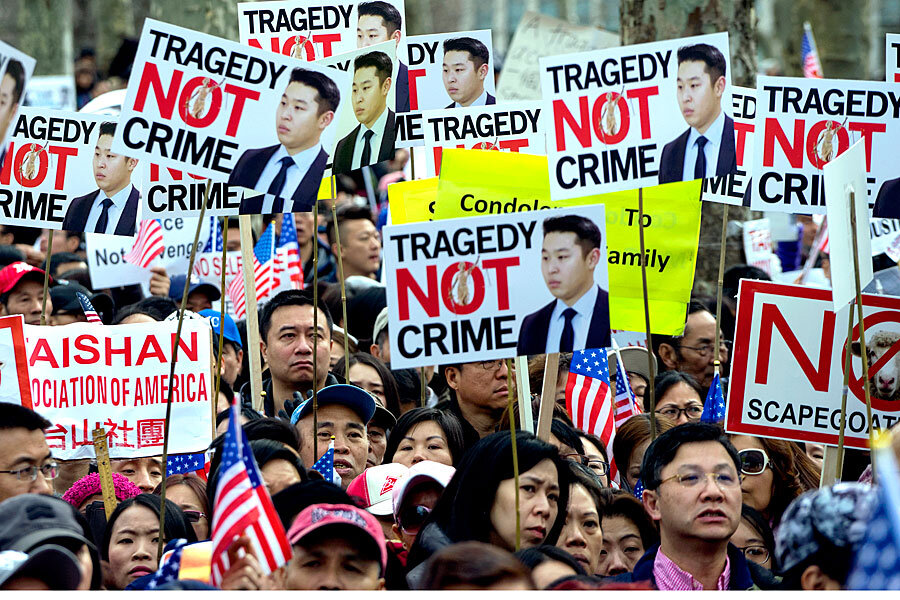How Chinese American protesters are invoking Black Lives Matter
Loading...
Jam-packed in a Brooklyn plaza Saturday, thousands of New York City’s Chinese American residents gathered to protest the conviction of former police officer Peter Liang, who fatally shot Akai Gurley, an unarmed black man, in 2014.
Mr. Liang was found guilty of second-degree manslaughter two weeks ago and faces up to 15 years in prison. But the roughly 10,000 protesters argue that the police department had unfairly sent Liang, who at the time of the incident was a rookie on the force, into a violence-ridden housing project.
They say that he is victim of prejudice himself, amid a criminal justice system that favors white officers like Daniel Pantaleo, who choked Eric Garner to death and yet eluded indictment.
Bearing signs that read “No Scapegoat!” and “One Tragedy, Two Victims,” the protesters – some of whom travelled from Connecticut and New Jersey – drew a connection between the fate of Liang and some of the recent deaths of unarmed African Americans at the hand of the police.
As reported by Gothamist, former City Comptroller John Liu addressed the thundering crowd, highlighting this link.
“We understand the pain among our African-American brothers and sisters, who have witnessed the killing of one unarmed black man after another in continuous succession, with no prosecutions against the officers," he said.
“So in an incident where an Asian-American officer shoots his gun, not aiming at anybody, shoots it by accident, we were all shocked last Thursday, when the guilty verdict came out,” he went on. “But were we really shocked?”
“For 150 years, there’s been a common phrase in America: ‘Not a Chinaman’s chance,’ which means if you’re Chinese in America, there’s no hope for you.”
But prosecutors characterized Liang’s conduct as reckless when he opened fire inside the Louis H. Pink Houses, arguing that he was also unsympathetic to Mr. Gurley after the shooting.
"While we know that Peter Liang did not intend to kill Akai Gurley, he was convicted because his reckless actions cost an innocent man his life," Brooklyn District Attorney Ken Thompson told NBC News in an email statement Friday.
"This case is about what happened in Brooklyn, not Ferguson or Staten Island, and the jury convicted on the basis of these unique and tragic facts. My office will continue to pursue equal justice for all of Brooklyn."
And the protest wasn’t met with unequivocal support. A simultaneous counter-protest emphasized the injustice of Gurley's death and the importance of punishment. Members of an Asian American organization known as CAAAV were among those supporting Black Lives Matter activists in backing Liang’s conviction.
Soraya Sui Free, a nurse from the Bronx, was one of the participants in the counter-protest. She stood with a group donning signs that said, “Jail Killer Cops.”
“Where is the empathy?” she said to The New York Times. “Peter Liang made a decision for Akai Gurley, and that decision was to die.”
But despite the pushback, the Asian Americans standing behind Liang are not budging. The Brooklyn rally was part of a national day of protests in dozens of cities, including Ann Arbor, Los Angeles, San Francisco, Chicago, Philadelphia, and Boston.
Immediately following his conviction, Chinese American organizations began planning protests and fundraisers to help pay legal fees for Liang. Using social media outlets such as Facebook and WeChat, a popular Chinese app, they successfully mobilized support of Asian Americans across the country. A White House petition calling for the withdrawal of his indictment – a decision outside the scope of the president's powers – has garnered more than 120,000 signatures.
"We are sad and sorry for what happened,” Wally Wong, a day trader in New York, told Gothamist.
“But we are trying to send out a message: We are silent, but we are not always silent."






